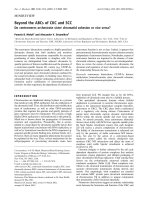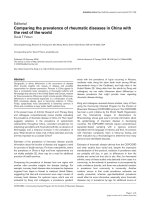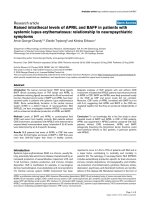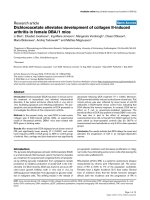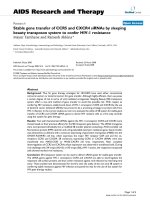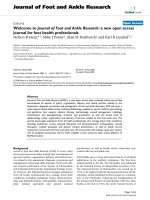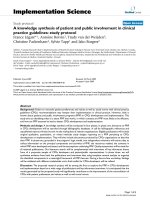Báo cáo y học: "Eighth World Congress of Intensive and Critical Care Medicine, 28 October–1 November 2001, Sydney, Australia: Harm minimization and effective risk managemen" doc
Bạn đang xem bản rút gọn của tài liệu. Xem và tải ngay bản đầy đủ của tài liệu tại đây (29.1 KB, 3 trang )
ARDS = acute respiratory distress syndrome; CRRT = continuous renal replacement therapy; ICU = intensive care unit; IIS = intensive insulin
schedule.
Available online />This report covers the 8th World Congress of Intensive and
Critical Care Medicine and the pre-congress satellite meeting
Ventilation and Oxygenation – Rainforest to Reef, held in
Cairns, Australia, 23–26 October 2001, and the post-
congress Symposium on Critical Care Nephrology, held in
Melbourne, Australia, 1–3 November 2001.
The world congress is one of the largest critical care
meetings in the world, with participation from researchers
and clinicians from all over the world. Despite the recent
tragic world events more than 2000 delegates attended the
meeting, which catered for anyone with an interest in critical
care and was hosted jointly by the Australian and New
Zealand Intensive Care Society (ANZICS) and the Australian
College of Critical Care Nurses, under the aegis of the World
Federation of Societies of Intensive and Critical Care
Medicine. Professor Malcolm McD Fisher of the Royal
Northshore Hospital, St Leonards, New South Wales,
Australia, presided over the conference.
This report focuses on the various scientific and social issues
that face us as clinicians, in terms of the diseases, the
technology, and finally ethical and social issues.
Acute respiratory distress syndrome (ARDS)
Dr Andrew Bersten of the Flinders Medical Centre, Bedford
Park, South Australia, Australia, presented data on biological
markers in ARDS. Surfactant protein B, a specific pulmonary
epithelial marker with a short half-life, predicts the
development of ARDS after an inciting event with high
specificity and sensitivity. He stressed the need for large
studies with multiple markers in predicting who will or will not
develop ARDS.
Dr Marco Ranieri of the Università di Bari, Ospedale
Policlinico, Bari, Italy, presented his new strategy of
ventilation with the use of the stress index, which uses the
slope of the pressure–volume curve to avoid the risks of
ventilator-induced lung injury.
Metabolic and endocrine disorders
This was, by a long way, the session in which work was
presented that could lead to fundamental changes in
intensive care practice. Dr Greet Van den Berghe of the
University of Leuven, Belgium, presented the results of a
prospective randomised controlled study on the management
Meeting report
Eighth World Congress of Intensive and Critical Care Medicine,
28 October–1 November 2001, Sydney, Australia: Harm
minimization and effective risk management
Naresh Ramakrishnan
Royal Melbourne Hospital, Parkville, Victoria, Australia
Correspondence: Naresh Ramakrishnan,
Published online: 28 November 2001
Critical Care 2002, 6:89-91
© 2002 BioMed Central Ltd (Print ISSN 1364-8535; Online ISSN 1466-609X)
Abstract
The 8th World Congress saw the presentation of several late-breaking findings, such as the role of
insulin in reducing mortality, and technologies such as vital microscopy. There were heated debates for
and against the role of gastric tonometry, enteral nutrition, extracorporeal membrane oxygenation, the
question of ‘closed’ or ‘open’ intensive care units, and several others. The overall message was the
need to study outcomes and practise intensive care in a sensitive and humane fashion.
Keywords acute respiratory distress syndrome, critical care, haemofiltration, insulin, sepsis
Critical Care February 2002 Vol 6 No 1 Ramakrishnan
of hyperglycaemia in critically ill patients. A total of 1548
medical and surgical patients were randomised on admission
either to a strict normalization of blood sugar to
4.5–6.1 mmol/l, using a continuous infusion of insulin called
the ‘intensive insulin schedule’ (IIS), or to a conventional
strategy of treating blood sugar levels above 12.0 mmol/l with
the ‘restrictive insulin schedule’ (RIS). The patients tested
were all those admitted to the unit and were well matched at
inclusion. In the IIS group the mortality in the intensive care
unit (ICU) fell by 43% (35 versus 63 deaths) and hospital
mortality by 34%. The odds ratio on the IIS group (corrected
for all univariate predictors of ICU death) was 0.52
(0.33–0.82) (P = 0.004). This decrease in mortality was seen
exclusively in long stayers (more than 5 days in ICU) and was
from a reduction in multi-organ failure. There were few
episodes of hypoglycaemias but no long-term sequelae. The
blood sugar levels in the IIS were monitored hourly until
stable then at 4 hour intervals from then onwards. This low-
cost solution for reducing ICU mortality seems promising. As
with any study, one needs to apply the findings to one’s own
patients, mindful of one’s own system limitations. It would be
important for this study to be repeated.
Dr Van den Berghe also presented data on the role of pituitary
failure in patients who are critically ill for protracted periods.
Sepsis
Dr John-Louis Vincent of the Erasme Hospital, Brussels,
Belgium, presented an overview of the study of sepsis so far
and suggested that we move to a new definition, namely the
IRO staging system: I for infection (localised, generalised or
extensive), R for response (limited, extensive or excessive)
and O for organ dysfunction (mild, moderate or severe), akin
to the TNM staging of cancers.
Most of the sessions on sepsis focused on the role of
coagulation and the factors affecting it. The data on
drotrecogin alfa (activated) in severe sepsis (PROWESS
study) were presented. Dr Peter E Morris of the Wake Forest
University School of Medicine,Winston-Salem, North
Carolina, USA, stressed the importance of patient selection
and the caveats of using the drug. He also advocated good
supportive intensive care.
Dr Simon Finifer of the Royal Northshore Hospital, St
Leonards, New South Wales, Australia, presented
prospective data involving 3548 patients from 21
Australasian ICUs from the ANZICS Clinical Trial group on
the incidence and outcomes from severe systemic
inflammatory response syndrome and sepsis. The overall
mortality was 15.2%. Of this group, deaths were considered
definitely preventable in 2.4% and possibly preventable in
23.1%. Although the overall mortality was comparable and
lower than in other large national datasets, this thought-
provoking and colossal study raises an important issue in
intensive care: that of harm minimisation and risk
management.
Microcirculation and oxygen delivery
Dr Can Ince of the Academic Medical Center, Amsterdam,
The Netherlands, presented his work on the development
and use of orthogonal polarization spectral imaging or vital
microscopy as a technique for the study of the
microcirculation, and in particular the effects of vasoactive
substances in tissue beds in shock. This promises to be an
important new technology. Dr Bala Venkatesh of the Royal
Brisbane Hospital, Herston, Queensland, Australia,
presented some exciting work on tissue oxygen monitoring.
This technology is in its infancy and there are several
questions that remain unanswered, the main being which
tissue bed should be monitored. Speaking on the oxygen
affinity of haemoglobin, Dr Thomas J Morgan of the Royal
Brisbane Hospital, Herston, Queensland, Australia, spoke of
new drugs on the horizon that can manipulate the P
50
point
of the oxygen dissociation curve. RSR-13, a molecule derived
from the lipid-lowering agent clofibrate, is currently being
studied. He stressed the importance of drugs that can not
only shift the curve but alter the shape of the curve (‘co-
operativity’) itself.
Transfusions in critically ill patients
Dr Craig French of The Sunshine Hospital, St Albans,
Victoria, Australia, presented a large dataset on the use of
blood products in the Antipodes. These were results from a
large prospective survey to document the indication for and
appropriateness of blood transfusion involving 1808
admissions in 18 Australasian ICUs. The most common
indications for transfusion were acute bleeding, diminished
physiological reserve and altered tissue perfusion.
Institutional transfusion rates were positively correlated with
median pre-transfusion haemoglobin levels and the
percentage of patients with a cardiovascular diagnosis who
received a transfusion. Large epidemiological datasets such
as this will assist the development of further trials of
transfusion and appropriate use of blood products in ICU
patients.
Critical-care nephrology
Dr Carlos Scheinkestel of the Alfred Hospital, Prahran,
Victoria, Australia, presented some new work on the kinetics
of amino acids and nutritional support in patients on
continuous renal replacement therapy (CRRT). In 63 patients
with multi-organ failure on CRRT, he found that when
patients achieved a positive nitrogen balance their outcomes
were better. He also found that this was possible when
protein intake was increased to more than 2 g/kg per day.
The administered amino acids did not reach the
recommended blood levels until protein was administered at
more than 2.5 g/kg per day. Dr Rinaldo Bellomo of the Austin
& Repatriation Medical Centre, Heidelberg, Victoria,
Australia, presented in vitro data on the potential of newly
developed ‘super-high-flux’ CRRT membranes in achieving
significant clearance of cytokines such as interleukin-1
without losing albumin, by using haemofiltration and high-
volume exchanges. This therapy can potentially alter the way
in which we currently treat sepsis, because for the first time
we have a technique that can truly clear the plasma of the
proinflammatory mediators.
Ethics
Dr Charles L Sprung of the Hadassah-Hebrew University
Medical Centre, Jerusalem, Israel) presented the results of
the ETHICUS study, which looked at physician behaviour
with regard to end-of-life decisions in 37 centres from 17
countries across Europe. Dr Stephan J Streat of the
Auckland Hospital, New Zealand, argued that early
withdrawal of intensive therapy in severely brain-injured
patients is not merely justified but obligatory. In his study
involving 66 patients with severe traumatic brain injury (acute
injury score > 4, Glasgow coma scale < 3) of a total of 627
who were prospectively followed, 65 died (58 in ICU) within
a median of 5 days. The only survivor was severely disabled.
Conclusion
In the words of Professor Luciano Gatinoni, ‘Our Australian
colleagues have put together a scientific programme which
reflects cutting edges of science and the wisdom of experts
in all aspects of critical care.…’ The Congress provided a
forum in which researchers and clinicians could come
together and look at the questions facing us as a speciality in
these troubled yet exciting times. We reflected on what we
have achieved and what is needed. The central theme was
that the focus should be on harm minimization and effective
risk management. This could require the application of the
best available evidence to each patient and, on a more global
scale, an investigation of the problem further, applying
improved techniques of both research and methodology.
I feel we are at a unique moment in history; to quote George
Santayana, ‘… nature is more than substance; it is a system
of movements, forms, and transformations, which have their
specific being in the realm of truth. This realm is non-natural
in one respect; it is eternal….’ Let us dedicate ourselves to
the pursuit of this truth.
Competing interests
None.
Available online />
